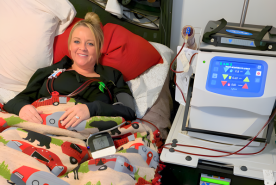Peritoneal dialysis uses the lining of your belly to filter blood when kidneys fail. Learn about the process, types, pros and cons, and payment options.
Before dialysis was available, total kidney failure meant death. Today, people with kidney failure can live because of treatments such as dialysis and kidney transplant.
Are there different types of dialysis?
There are two kinds of dialysis. In hemodialysis, blood is pumped out of your body to an artificial kidney machine, and returned to your body by tubes that connect you to the machine. In peritoneal dialysis, the inside lining of your own belly acts as a natural filter. Wastes are taken out by means of a cleansing fluid called dialysate, which is washed in and out of your belly in cycles.
Dialysis
Sign up for a deep dive into dialysis
Learn about the different types of dialysis, receive additional resources, and learn so much more.
Types of peritoneal dialysis
There are two kinds of peritoneal dialysis:
- Continuous Ambulatory Peritoneal Dialysis (CAPD)
- Automated Peritoneal Dialysis (APD)
The basic treatment is the same for each. However, the number of treatments and the way the treatments are done make each method different.
CAPD is "continuous," machine-free and done while you go about your normal activities such as work or school. You do the treatment by placing about two quarts of cleansing fluid into your belly and later draining it. This is done by hooking up a plastic bag of cleansing fluid to the tube in your belly. Raising the plastic bag to shoulder level causes gravity to pull the fluid into your belly. When empty, the plastic bag is removed and thrown away.
When an exchange (putting in and taking out the fluid) is finished, the fluid (which now has wastes removed from your blood) is drained from your belly and thrown away. This process usually is done three, four or five times in a 24-hour period while you are awake during normal activities. Each exchange takes about 30 to 40 minutes. Some patients like to do their exchanges at mealtimes and at bedtime.
APD differs from CAPD in that a machine (cycler) delivers and then drains the cleansing fluid for you. The treatment usually is done at night while you sleep.
What are the pros and cons about being on peritoneal dialysis?
Some doctors feel that CAPD and APD have several benefits when compared to hemodialysis. With continuous dialysis, you can control extra fluid more easily, and this may reduce stress on the heart and blood vessels. You are able to eat more and use fewer medications. You can do more of your daily activities and it is easier to work or travel.
However, there are some people for whom peritoneal dialysis may not be appropriate. The abdomen or belly of some people, particularly those who are morbidly obese or those with multiple prior abdominal surgeries, may make peritoneal dialysis treatments difficult or impossible. Peritonitis (infection of abdomen) is an occasional complication although should be infrequent with appropriate precautions. When making a decision about the type of treatment, you should take into consideration that peritoneal dialysis is usually a daily process, similar to the working of the kidney and may be more gentle with fluid removal from the body. Peritoneal dialysis is an effective form of dialysis, has been proven to be as good as hemodialysis.
Peritoneal dialysis is not for everyone. People must receive training and be able to perform correctly each of the steps of the treatment. A trained helper may also be used.






